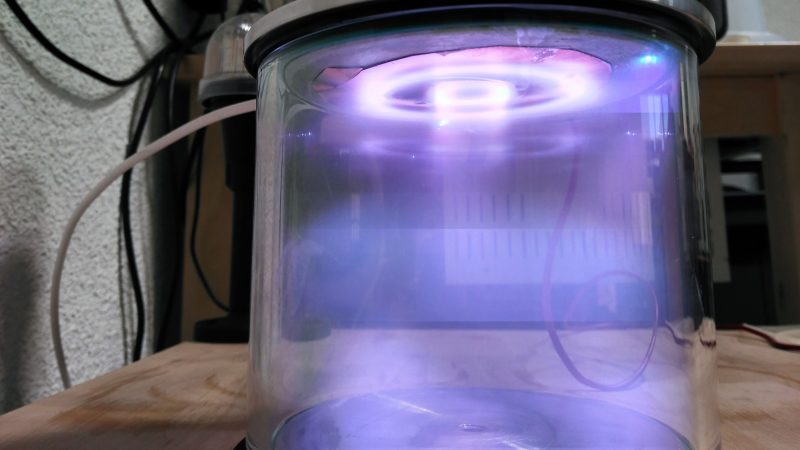[Nixie] wants to sputter. We know, who doesn’t? But [Nixie] has a specific purpose for his sputtering: thin-film deposition, presumably in support of awesome science. But getting to that point requires a set of tools that aren’t exactly off-the-shelf items, so he’s building out a DIY sputtering rig on the cheap.
If you’re not familiar with sputtering, that’s understandable. In this context, sputtering is a process that transfers particles from one solid to another by bombarding the first solid with some sort of energetic particles, usually electrons or a plasma. When properly controlled, sputtering has applications from mass spectrometry to the semiconductor industry, where it’s used to either deposit thin films on silicon wafers or etch them away selectively.
No matter the application, sputtering needs a stable stream of plasma. [Nixie] has posted a series of articles on his blog walking us through his plasma experiments, from pulling a really strong vacuum to building a high-voltage power supply from a microwave oven transformer. It’s a project that needs a deep well of skills and tools, like glassworking, machining, and high-voltage electronics. Check out the plasma in the video below.
Will [Nixie] be using this for a DIY fab lab? Will it be used to make homebrew LEDs? The world waits to hear.















Gonna grow some diamonds?
Nope! Guess again. XD
Does it have to do with making your own Nixies?
Nope either!
L’ets say that my next posts will ramp up the heat quite a lot. XD!
Fusion experiments?
Nope! ;)
(The vacuum chamber is too small for that).
DIY FETs?
Yeeeeees!
Awesome! I’m sure you’ve already seen the work of Jeri Ellsworth: https://www.youtube.com/watch?v=w_znRopGtbE
Yes! ^^ Also Sam Zeloof’s.
I would like to have my name in that referrer list someday.
Great, now I want to replicate my Gigatron TTL microcomputer on a homebrew IC. And after that, next will be growing and doping my own substrates?
The Czochralski process is too temperature crytical for me to attempt, plus wafers are so readily avaliable…
Sputtering..,,, same as plasma etching? We work with high voltage a lot, obviously potting is important, but, we have to plasma etch the polypropylene so epoxy will stick. A large plasma etcher is expensive, I wonder if this would work the same but for smaller quantities, like lab stuff onesy, twosy kind of stuff.
As far as I know, if I don’t concentrate the plasma with the plasma trap, i should be able to do that, or at least plasma clean, wich might nit be the same.
In principle sputtering systems can have the polarity of the gun reversed and thus sputter (etch) the substrate. Some small microscopy sputter coating systems have a control knob for just this purpose. I’ve attempted to do surface modification in etch mode with O2 in the gas mix, and it does work on all the plastics I tried. It also works on Si wafers and marginally on crystalline quartz.
FYI sticking a hard drive magnet in a sputter coater in etch mode is very cool: Homebrew northern lights.
Anyone else worried about the generation of X-Rays?
Don’t look at the setup with remaining chromosomes :)
Not at these voltage levels.
The microwave oven transformer will output around 2200V before the doubler.
That’s nowhere enough for X-Ray generation.
The X-Ray energy would be 4400 eV. Too low to pass through the glass of the chamber.
In case you’re curious, I’ve found 30kV is about as low as you can go, voltage wise, to generate anything approaching an x-ray (or that will atleast trip the phosphor in the screen I used)
The term you’re looking for is https://en.wikipedia.org/wiki/Bremsstrahlung
I did not watch the video but in the off chance that he’s not aware, Ben Krasnow (Applied Science?) has some YT videos about his sputtering setup.
Exactly! I studied his vacuum chamber and designed mine trying to avoid his drawbacks. (mainly vacuum pass throughs and such.)
Cool. I wish you great suck-cess :)
+1 on that post-pun.
XD!
I wonder could it also be used for home made telescope mirrors?
I have seen some DIY sputtering setups, I think, but I can’t remember if these were for laser or telescope mirrors.
As far as I have seen on YT, they were used for telescope mirrors, but sputtering gold would work for laser mirrors too.
(Shame I changed mine to Molibdenum mirrors, wich are more scratch/heat resistant :P )
You want to evaporation for coating mirrors. Either thermal or electron beam. Sputtering has a much larger grain size than evaporation.
And is too slow compared to evap for the things I’ve tried…
With a good magnetron sputter gun and power supply I can deposit really fast. Sputtering is generally much faster than evap.
Can we put all the awesome guys like this in one big lab and not let them out until they make a full IC fab
I just found this article which reminded me of a place I worked making thin film resistors , briefly fixing stuff and then running a laser trimmer. The sputtering system was made by one of the company founders and handled 15 ceramic plates at a time. I wasn’t an engineer but had frequent chats with them and one issue was the vacum pump has the nasty habit of belching oil back onto the plates occasionally. The engineer suggested using a cryo pump (the impeller looked like a corkscrew) and the owner of the company took it personally HOW DARE YOU SUGGEST MY CREATION ISN’T PERFECT attitude lol.
They got bought out by a bigger company but are still there